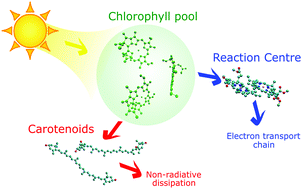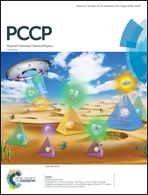The carotenoid pathway: what is important for excitation quenching in plant antenna complexes?†
Abstract
Plant light-harvesting is regulated by the Non-Photochemical Quenching (NPQ) mechanism involving the reversible formation of excitation quenching sites in the Photosystem II (PSII) antenna in response to high light. While the major antenna complex, LHCII, is known to be a site of NPQ, the precise mechanism of excitation quenching is not clearly understood. A preliminary model of the quenched crystal structure of LHCII implied that quenching arises from slow energy capture by Car pigments. It predicted a thoroughly quenched system but offered little insight into the defining aspects of this quenching. In this work, we present a thorough theoretical investigation of this quenching, addressing the factors defining the quenching pathway and possible mechanism for its (de)activation. We show that quenching in LHCII crystals is the result of slow energy transfer from chlorophyll to the centrally-bound lutein Cars, predominantly the Lut620 associated with the chlorophyll ‘terminal emitter’, one of the proposed in vivo pathways. We show that this quenching is rather independent of the particular species of Car and excitation ‘site’ energy. The defining parameter is the resonant coupling between the pigment co-factors. Lastly, we show that these interactions must be severely suppressed for a light-harvesting state to be recovered.



 Please wait while we load your content...
Please wait while we load your content...